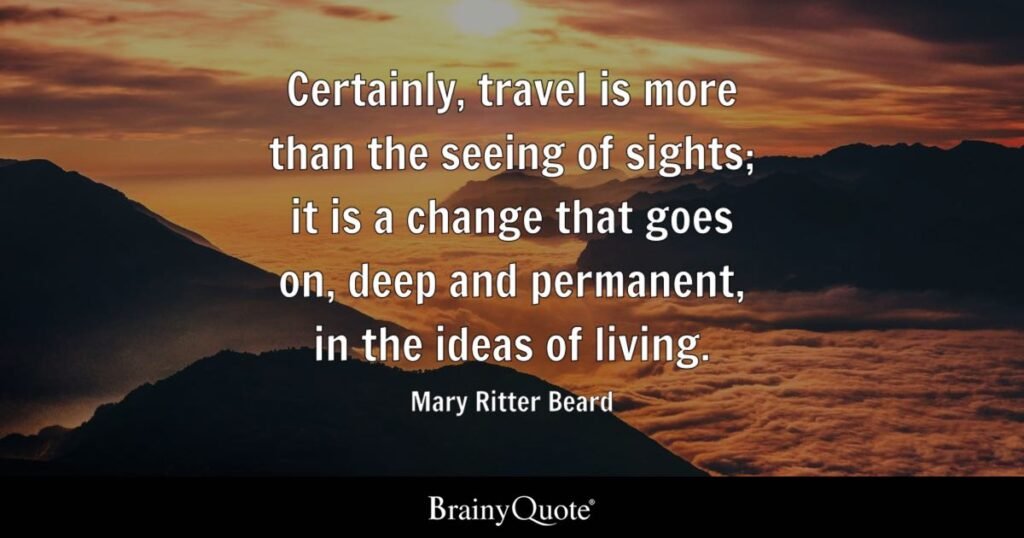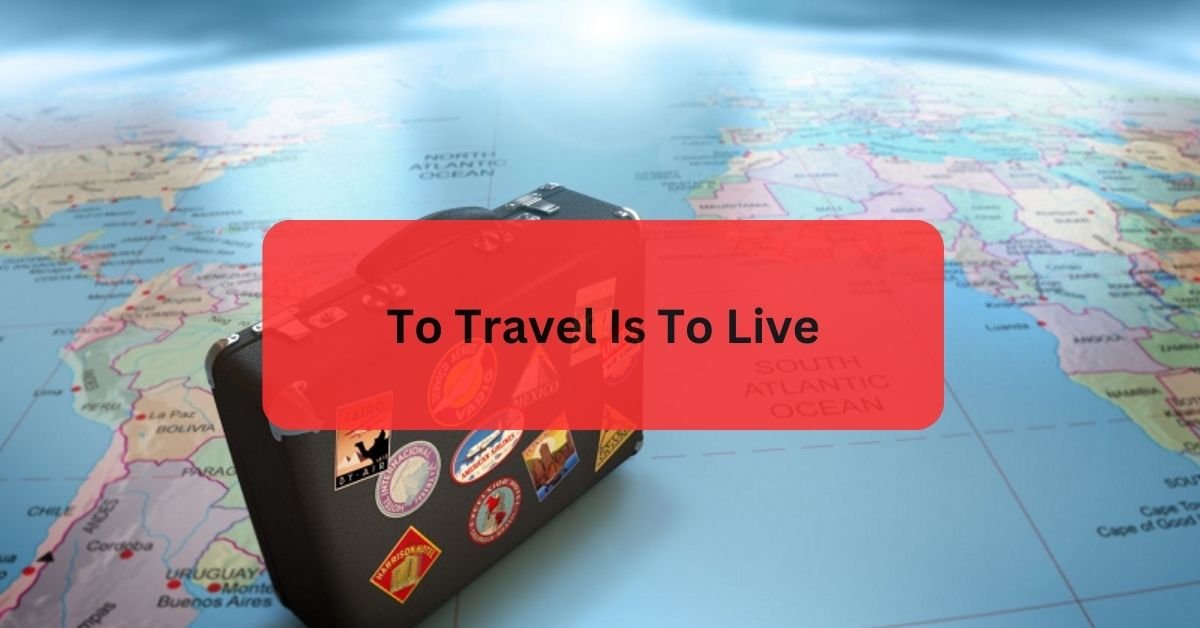Traveling opens doors to experiences you never imagined possible. It’s a passport to personal growth, pushing you beyond your comfort zone and teaching you invaluable life lessons.
The quote means that living is about more than just staying still. It’s about experiencing life fully, like moving, breathing, flying, and floating. Hans Christian Andersen highlights the essence of travel as a transformative experience filled with freedom, discovery, and reciprocity.
Every adventure teaches you more about the world and where you fit into it. So, why settle for a mundane existence when you can embark on a lifetime journey?
How This Quote Has Inspired Countless Travelers Throughout History!
The quote “To travel is to live” has been a guiding light for adventurers throughout history, igniting curiosity and wanderlust within countless souls.
It encapsulates the profound belief that authentic living is found not in the mundane routine but in exploring new horizons and discovering oneself amidst unfamiliar landscapes.
From ancient pilgrims seeking spiritual enlightenment to modern-day backpackers chasing adrenaline-fueled thrills, this quote has inspired individuals to step outside their comfort zones, confront their fears, and embrace the transformative power of travel as a journey of self-discovery and personal growth.
To Travel Is To Live Quote Origin And Context – Check It!

The famous quote “To travel is to live” is widely attributed to Hans Christian Andersen, the renowned Danish author celebrated for his enchanting fairy tales.
Although Andersen is best known for classics like “The Little Mermaid” and “The Ugly Duckling,” his contributions extend beyond children’s literature.
Andersen’s Life and Travels:
Born on April 2, 1805, in Odense, Denmark, Hans Christian Andersen led a life marked by both literary genius and wanderlust. Despite humble beginnings, Andersen’s talent for storytelling was evident from a young age. However, his insatiable curiosity and thirst for adventure set him apart.
Early Influences and Wanderlust:
Andersen’s childhood was colored by poverty and hardship, yet he found solace in books and theater. His love for storytelling was nurtured by the folk tales and legends he encountered, igniting a desire to explore the world beyond the confines of his small town.
Journeys of Discovery:
As a young man, Andersen embarked on a series of travels that would shape his worldview and inspire his literary works. His journeys took him across Europe, from bustling cities to remote villages, allowing him to immerse himself in different cultures and landscapes.
Impact on Andersen’s Writing:
Andersen’s experiences with travel served as a wellspring of inspiration for his stories, infusing them with a sense of wanderlust and adventure. His tales often feature protagonists who embark on transformative journeys of self-discovery, mirroring Andersen’s quest for meaning and fulfillment.
Creation of the Quote:
Within this context of exploration and discovery, Andersen is believed to have coined the iconic phrase, “To travel is to live.” For him, travel was not merely a physical journey but a metaphor for life—a journey of self-discovery, growth, and enlightenment.
Legacy and Enduring Influence:
Today, Hans Christian Andersen’s legacy lives on through his timeless tales and the enduring wisdom of his words. The quote “To travel is to live” continues to inspire travelers around the globe, reminding them of the transformative power of exploration and the boundless possibilities that lie beyond the horizon.
Read: Are Traveller Batteries Any Good – The Portable Energy Power!
The Deeper Meaning Behind The Quote And Its Implications For Travelers!

Interpretation and Meaning:
The quote “To travel is to live” encapsulates a profound truth about the nature of human existence and the essence of the journey through life. It goes beyond the mere act of moving from one place to another, inviting travelers to embrace the transformative power of exploration and discovery.
Embracing New Experiences, Cultures, and Perspectives:
- Traveling is not merely about ticking off destinations on a bucket list; it’s about immersing oneself in the richness of diverse cultures and experiences.
- Each new place visited offers an opportunity to expand one’s horizons and learn from different customs, traditions, and ways of life.
- By stepping outside of familiar surroundings, travelers are challenged to confront preconceived notions and biases, fostering empathy and understanding for people from different backgrounds.
A Transformative Journey:
- Travel has the potential to be a profoundly transformative journey, one that enriches the traveler’s life in ways they may never have imagined.
- Travelers are pushed beyond their comfort zones through encounters with unfamiliar landscapes, languages, and customs, encouraging personal growth and self-discovery.
- Traveling allows individuals to break free from the routine of everyday life, sparking a sense of adventure and curiosity that reignites their passion for living.
Enriching One’s Life and Broadening Horizons:
- Travel opens doors to new possibilities and opportunities, providing a fresh perspective on life’s challenges and triumphs.
- It broadens one’s horizons, expanding the mind and nurturing a sense of openness to the world and its infinite possibilities.
- Whether it’s scaling mountain peaks, exploring ancient ruins, or simply strolling through cobblestone streets, every travel experience leaves an indelible mark on the traveler’s soul, enriching their life in ways that extend far beyond the duration of the journey.
The Inspiring Wanderlust – You Should Know!

Exploration of Uncharted Territories:
Encouraging others to explore uncharted territories involves sharing stories of adventure and discovery, motivating them to step outside their comfort zones and seek out hidden gems off the beaten path.
By recounting personal experiences in lesser-known destinations, we ignite a sense of curiosity and excitement, inspiring others to embark on journeys of exploration and self-discovery.
Celebration of Diversity and Culture:
Celebrating diversity and culture entails sharing the richness of global cultures and traditions, fostering an appreciation for the interconnectedness of humanity.
Through storytelling and cultural exchange, we encourage others to embrace different ways of life, broadening their perspectives and deepening their understanding of the world around them.
Connection with Nature and the Outdoors:
Connecting with nature and the outdoors involves sharing experiences that showcase the beauty and tranquility of natural landscapes.
By recounting adventures in pristine wilderness or on sun-kissed beaches, we inspire others to escape the hustle and bustle of daily life and immerse themselves in the wonders of the natural world.
Embrace of Adventure and Spontaneity:
Encouraging the embrace of adventure and spontaneity means inspiring others to seize the moment and embrace the thrill of the unknown.
By sharing stories of impromptu road trips, spontaneous hikes, and unexpected encounters, we encourage individuals to break free from routine and embrace the spontaneity of travel.
Cultivation of Lifelong Memories and Connections:
Cultivating lifelong memories and connections involves sharing stories of meaningful encounters and lasting friendships formed through travel.
By highlighting the importance of experiences over possessions and the value of human connections, we inspire others to cherish the moments that truly matter and create lasting memories that enrich their lives.
Read: Can Electricity Travel Through Rubber – Unveil The Mystery!
Frequently Asked Questions:
1. What does “To travel is to live” mean?
This quote suggests that authentic living is found in the exploration and discovery that comes with travel. It emphasizes the transformative power of experiencing new places, cultures, and perspectives.
2. Who first said “Traveling means living”?
The phrase is commonly attributed to Hans Christian Andersen, the Danish author known for his fairy tales.
3. How does travel enrich one’s life?
Travel enriches one’s life by exposing them to new experiences, broadening their perspectives, and fostering personal growth and self-discovery.
4. Why is travel considered a transformative journey?
Travel is considered transformative because it challenges individuals to step outside their comfort zones, confront their fears, and embrace new opportunities for growth and exploration.
5. How can I incorporate more travel into my life?
Start by prioritizing travel in your budget and schedule. Consider planning shorter trips or weekend getaways if more extended vacations aren’t feasible. Look for travel opportunities that align with your interests and passions.
6. What are the benefits of embracing the ethos of “to travel is to live”?
Embracing this ethos opens doors to new experiences, fosters personal growth, and encourages a deeper appreciation for the world and its wonders.
7. How can travel foster curiosity, creativity, and a sense of adventure?
Travel exposes individuals to unfamiliar surroundings and challenges, sparking curiosity and creativity. It encourages them to try new things, explore new cultures, and embrace the unknown.
8. What should I keep in mind when planning a trip?
Research your destination thoroughly, consider your budget and timeframe, and be open to unexpected experiences. Remember to prioritize safety and respect local customs and cultures.
9. How can I make the most of my travel experiences?
Stay present in the moment, immerse yourself in the local culture, and be open to new experiences and perspectives. Take time to reflect on your experiences and cherish the memories you create.
10. Why is travel an essential aspect of personal growth and development?
Travel exposes individuals to diverse cultures, challenges them to step outside their comfort zones, and fosters resilience and adaptability. It encourages self-discovery, broadens perspectives, and creates lasting memories and connections.
Conclusion:
“To travel is to live” encapsulates adventure, exploration, and self-discovery. From its origins attributed to the Danish author Hans Christian Andersen to its enduring impact on travelers throughout history, this quote serves as a powerful reminder of the transformative power of travel.
It’s not merely about visiting new places but also about embracing new experiences, cultures, and perspectives. Travel enriches our lives, broadens our horizons, and fosters connections with the world. By adopting the ethos of “to travel is to live,” we embark on journeys that ignite our curiosity, creativity, and sense of adventure, enriching our lives in ways we never thought possible.
Read: Are Traveler Winches Any Good? – Everything You Need To Know!




